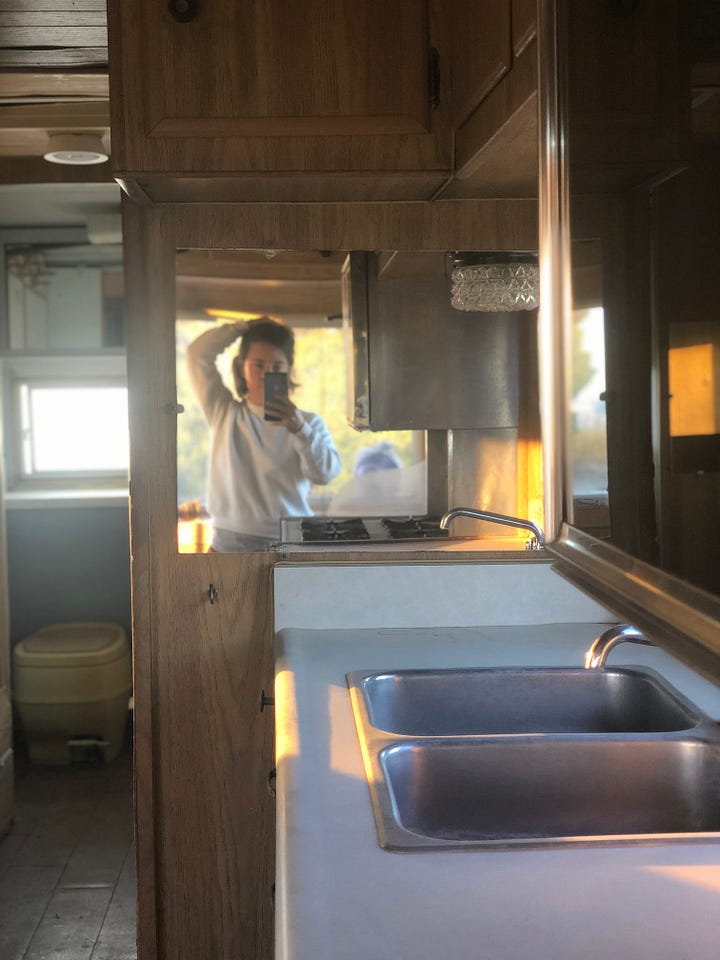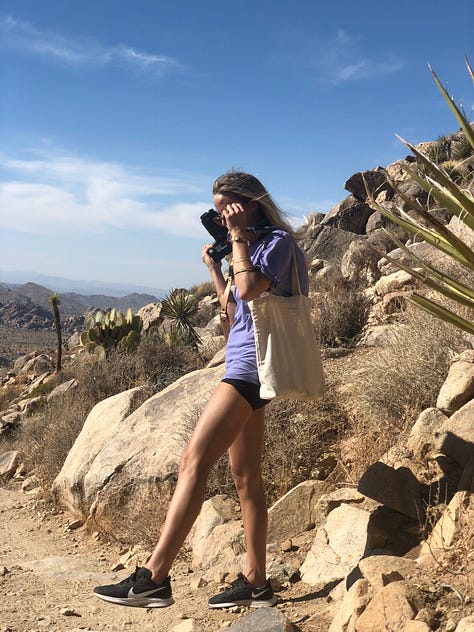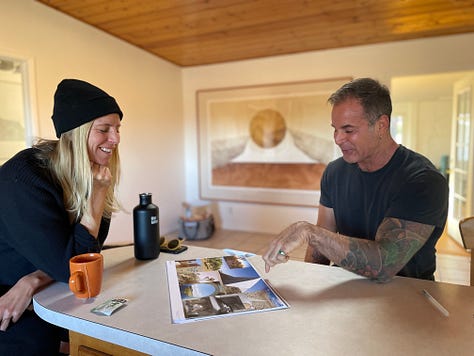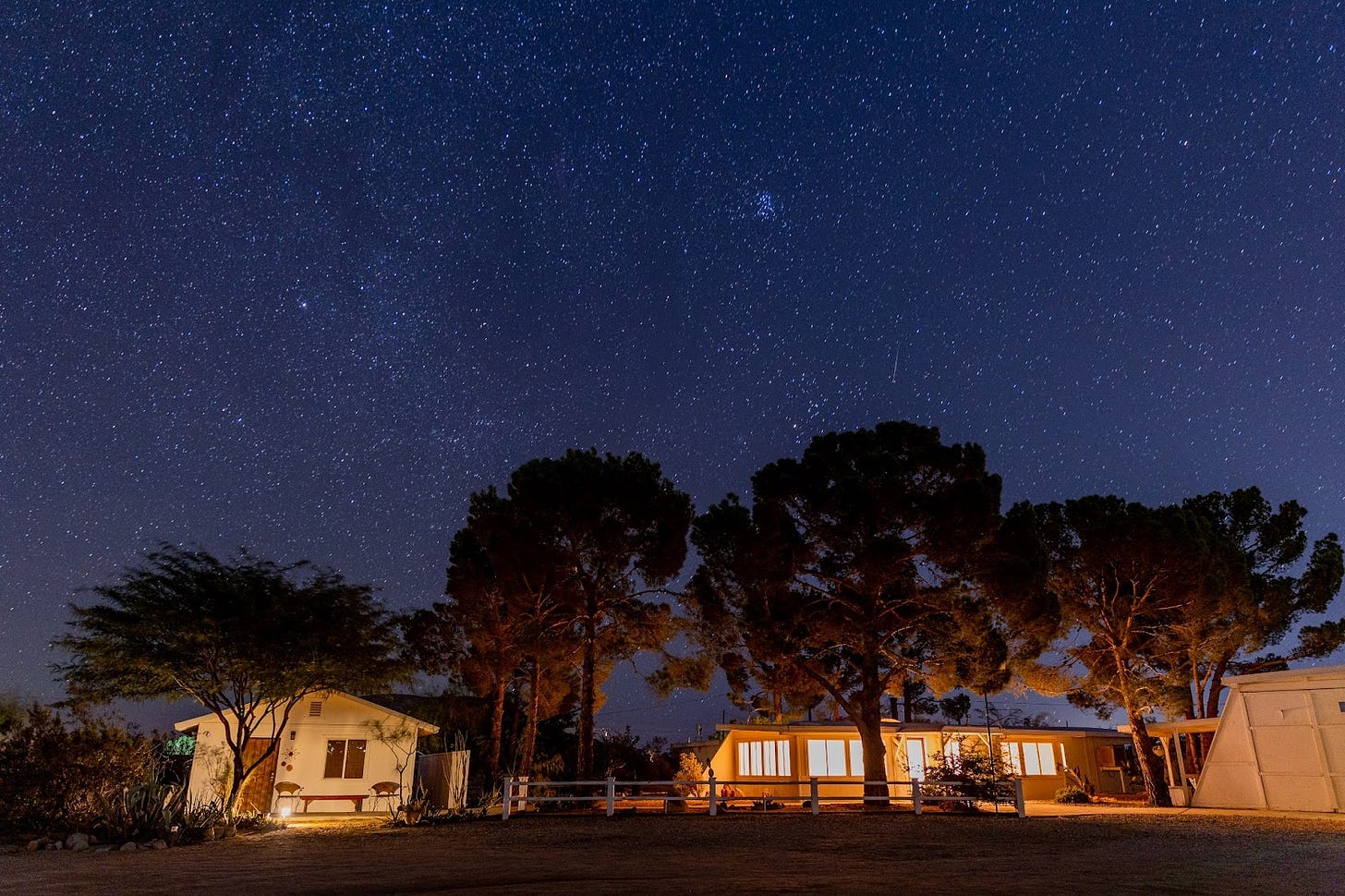On Kismet—#1
By Jessica M. Castillo
Driving out, out, out from civilization, crossing Reche Rd, the hard if patchy pavement turning to crumbly rock and then to finer rock, I see two horses share a meager spit of grass in a sea of sand in the shade of a small ranch. I notice them especially because I realize I haven’t seen a large mammal in days. Turning onto Jackrabbit Road from Landers Lane, seeing the faded yellow fire hydrant half-submerged in sand, shrouded in tumbleweeds and dappled with light through zany Joshua Trees, I wonder if the green placards and metal pole denoting the intersection (sans Stop sign) have always been there. Since the first homesteaders’ time, the 1960s, perhaps? Doubtful.
As I drive down the wavy road, spotting a jackrabbit out of the corner of my eye, my heart drops as I get half-stuck in the sand, not unlike the fire hydrant. I change gears to get unstuck, my panic subsiding, and I become giddy with excitement at the remoteness. I’m out here. A 20-minute ride north of the town of Joshua Tree, and fewer than ten minutes from the famed Integratron, Giant Rock, and Goat Mountain. Windows down, there’s a distant smell of firewood mixing with the outdoors, like freshly stirred clay, earthenware that cradles you. All I can hear is the crunchy, rocky sand thin out to a whisper in the cool, late October air. I’m a long way from home in Miami. I’m also particularly poised and distinctly equipped for this adventure away and within. I’ve traveled alone plenty, including a six-month road trip across the country visiting National Parks. And, in the past year, I’ve written a novel (still can’t believe it), journeyed from the Inca Trail in Peru and a writing retreat in Paris, to the Ring Road around Iceland and a street photography workshop in New York. It’s not my first time experiencing Jackie, as friends and lovers of Jackrabbit Studios affectionately call her, but it’s my longest so far, and I’m alone. Or, as we’d say at Jackrabbit: sola.

Standing in front or behind the main house each night (and it is every night) to watch the sunset—the bulb of orange, red, and yellow inching and then hurtling across the Yucca Valley and over the ridge of the Little San Bernardino Mountains—I feel the stark harshness of the desert. I hear dogs barking and swifts chirping, and feel the whoosh of the resident Great Horned Owl swoop by me on my right to roost atop a branch of a Joshua Tree less than 50 feet away. It’s desolate and rough and hardy and dusty and barren and not for the fainthearted. And yet. As the sky and earth around me blend to impossible purples and pinks and blues, a quietness, a pregnant hush falls over everything, including me. It permeates from the raw nature—wilderness, and wildness. I almost forget to breathe, not wanting to disturb the stillness. Rather, I want to merge with it. I’m enveloped in Jackrabbit’s expansiveness. Out here in the desert, the aridity and sparseness create a restorative, generative exposure, one that doesn’t just invite but demands vulnerability. I am laid bare in the desert, this patch of the Mojave. It’s an openness that is also not for the fainthearted. Or the unintentional. It necessitates a certain caliber of strength to withstand the vastness. I feel grounded and balanced—a little scared and a lot awake. Wide awake with wonder to see what happens next, what rewards the desert will present to those brave enough to unfold.
As the sky and earth around me blend to impossible purples and pinks and blues, a quietness, a pregnant hush falls over everything, including me.

Throughout my stay at Jackrabbit, and particularly during sunsets and moonsets, with clear skies that let me see back in time to the start of the universe, I’m reminded of one word: kismet. Jennifer Azlant taught me the word. I hadn’t heard it before and, of course, she’d introduce me to it. Through this introduction, I’d come to know it intellectually, physically, emotionally, spiritually, in theory as well as practice, and as a lens to view the past, present, and future. Fate, destiny, divine timing. It’s what I think of when I think of Jen and Jackrabbit.
We met on a writing retreat in Mallorca in August of 2021 where she taught an editorial practices workshop. She was a year into serving as the current stewardess of Jackrabbit Studios in the California high desert. Her first independent venture of this kind, and a long-held dream-state kind of endeavor. Within five minutes of chatting, I sensed that Jen might be a mystical, wandering sage. A petite, potent powerhouse of a woman, she is the ultimate connector: of humans, of opportunities for creating and championing passions and passion projects, love, communion, understanding; and of lived intentionality.



I listened as Jen described some of her lives, including a melange of careers: in editing, publishing, and digital storytelling; movement and healing; investing in and tending to properties, land, and their inhabitants and expressions. Her late mother, Joan, whose father was a diplomat, was born and bar-mitzvahed in Cuba—land of my own paternal grandparents—and lived in Colombia, where my own strong and ethical mother and maternal lineage descend from. Mama Joan also passed down a sense of design, art, and celebration. She noticed early and often: Jen’s particular fondness for greens, and how she tended to others at her own childhood birthday parties. Her late father, Eddie, showed Jen blueprints for projects both creative and of the land—synchronously, and with care. My own dad is, similarly, enormously thoughtful and also a builder: he built me a wooden, carpeted balance beam when I was a nine-year-old gymnast (of course! Jen too at this age) and a red bookcase that’s been with me since 2013. Both our fathers forever supporting our balance and erudition. Jen spoke, too, about how she decided to take on a five-acre sanctuary in Landers, the details of this space for gathering and manifesting, its previous female artists and owners, and her future visions for it.
I was so drawn to Jen, now a dear friend, and to Jackrabbit Studios. And, she tells me, she was similarly drawn to me, as a like-minded creative:
“It's spectacularly rare to meet someone with a work ethic as steadfast, clarified—grounding—as Jessica's alongside such innate, and ever-evolving, propulsive creative gifts. After witnessing her unmatched observational prowess, stunning portrait photography, and boundless curiosity—brío—I couldn't help but sense we were meant to know each other, and continue to co-create. And how endlessly lucky, that sensing, these magics; we must trust in them.”
I loved Jen’s whole ethos and intention for Jackrabbit Studios, trusting the power of its magic and helping reach its fullest potential for uniting artists and makers and embracing them in one giant warm, inspired, inclusive desert hug. A month later, I celebrated my 33rd birthday at Jackrabbit. I felt renewed swinging by Jackie on my return home from a yoga and meditation retreat in Sedona. After just one night, I didn’t know how, but I hoped, I dreamed, that kismet would return yet again so that I could somehow work with Jen and help realize her vision for Jackrabbit in whichever ways I could—writing, photography, soundboarding. Also during these couple days, I accepted my first paid photo session with a client in Florida, giving the Universe a resounding ‘yes, I’m ready.’ Less than a year later, I quit my dozen-plus years working in government consulting for climate change and disaster recovery. My latest hyphenations would now be, simply, boldly: Writer-Photographer.



The desert is masculine, hard, and unforgiving in its rugged, rocky, spartan infertile landscape. At the same time, it’s incredibly feminine—exposed, open, vulnerable: honest. Life in the high desert since the inception of jackrabbit homesteading has fostered an effervescent rustic bohemia matched by settlers’ self-reliance and independence, and enamored by the romance of wide open expanses filled with extremes of hot and cold, bright and dark, delicate and rough, subtle and stark. The yin-yang, otherworldly energy of the high desert and, most palpably, of Jackrabbit Studios, makes it no wonder the sacred space has been most recently at the helm of three formidable, gracious women artists, makers, creators, and connectors. It exudes, and requires, balance.
Decidedly of the land, Jackie’s environs—towns named Joshua Tree, Yucca Valley, Twentynine Palms, and Pioneertown—give us a sense of the vibe of this high desert enclave. There are lots of native Joshua Trees in the Mojave Desert (survival through evolutionary adaptation is an art in itself), and Yucca trees and plants, as well as descendants of the original inhabitants and stewards of the land: the Cahuilla, Chemehuevi, Serrano, Western Shoshone, and Southern Paiute indigenous tribes. And the small oasis in the eastern hinterlands that allowed for dozens of (at least 29) palm trees to sprout, prompted the arrival of plenty of pioneers and settlers.
Jackrabbit Studios is so named as an ode to the furry, agile, big-eared desert dwellers seen throughout the Morongo Basin, including on this five-acre “desert Walden” in Landers, California. Its name is also a nod to the original homesteaders who purchased the land through the Small Tract Act of 1938, a homesteading program especially popular in post-war America and during the height of Hollywood Westerns (see again: Pioneertown). (Kismet, again: Eddie, who self-described as a media-hobo, worked as a writer, photographer, record producer, screenwriter, professor committed to the forgotten pioneers of film history, and had a particular fondness for the Western screenplay, writing several of his own.) Through the homesteading program, the U.S. federal government leased tracts of land deemed ‘disposable’ and then the leasee could purchase the land by “proving up”—building, within three years, a small dwelling worth at least $300 on the non-arable but still livable tract: termed ‘jackrabbit homesteads.’
The original owner and homesteader of this plot off Jackrabbit Rd. was Garland B. Childers, who was deeded the property in 1961 by the Bureau of Land Management, and promptly built a one-room cabin. The homestead then moved onto the Hanson family, elders and heirs. These first few owners primarily enjoyed soaking up desert cabin life, basking in the quietude of the Morongo Basin, freedom, and the many-hued rises and falls of the unrelenting high desert sun.

For the first 50 years, while many high desert dwellers sold off or simply left their jackrabbit cabins to dissolve back into the ancient sand from which they came, Jackie’s prior owners were some of the few that remained, under the romantic spell of the freedom and the unencumbered feeling of the desert. The ‘baby homestead’ program was available in 31 states but was most popular in California, Arizona, Nevada, Utah, and New Mexico. In the Morongo Basin and high desert, it was mostly Los Angelenos and southern Californians wanting to escape hectic urban life for a weekend or a lifetime, some wanting to establish creative sanctuaries of their own. It also included World War I and II veterans from all over the country whose doctors’ prescriptions were first and foremost: clean, thin desert air. The highest boom of jackrabbit homesteaders came in the late 1940s through the 50s and 60s, after the war ended and as building supplies rebounded, rationing ended, and the main thoroughfare—29 Palms Highway—was paved with blacktop.
How each of the two most recent owners came to acquire Jackrabbit has been fortuitous, seemingly downright lucky. But, upon closer reflection, the word is actually: destined. Kismet, even. The five-acre desert oasis shaded by six three-to-four-stories tall Pinyon Pine trees and dotted with rugged, quirky, lovable Joshua Trees, swooping owls, zigzagging iguanas, hopping namesake bunnies, and singing swifts was purchased in 2011 by Moira. A welder, sculptor, ceramicist, and painter, Moira took over the homestead with the intention of creating an artistic hamlet where she could have numerous efforts and mediums evolve alongside her living spaces. Her sculptures and tilework were integrated throughout, and a few relics still remain on the grounds. (When you come, see if you can find all of her homemade birdhouses. Remember to look high and low!)



In 2018, the property transitioned to Allison, an abstract artist and muralist who undertook renovations of parts of the property and made inspiring use of the studio space for her large-scale artworks and installations. Several masterpieces are preserved inside the interior living areas, including wall artwork in the initial bedroom and kitchen in the main house, and a (kismetic) woodcut of the property’s namesake creature, carved and crafted long before she ever knew of this land. A chance encounter with an old friend who showed her the real estate listing led Allison to bid on the high desert home in less than 24 hours after viewing the property. After a time, she felt called to pass it along to the next stewardess because her surfer heart beat a hertz louder for the beach.




Since 2020, Jackrabbit’s beloved proprietor and owner has been Jennifer Azlant: poet, writer, editor, athletic enthusiast, land stewardess, humanistic investor, and overall linchpin. Through the arts-and community-oriented Listings Project, she coincidentally (it’s never really a coincidence, is it? Hello, again, kismet) came across the listing less than 24 hours before it closed for offers. She’s incredibly intelligent and intellectual, in an accessible, endearing way. Speak with her for five minutes and you feel like you’ve known her for all of your lives. This is largely because she cares so deeply and genuinely about people—including friends and collaborators near and far—about words, storytelling, art, design, and intentional spaces. Her personal networks and efforts center largely around healing, community development, activism, and the arts.
Aside from her passion and care, which are intuitively embedded in the main house, the casita, and the studio workshop, her curios of art, friendship, family, and love abound in the same places. The property features work from several of the artists of her life, including a silkscreen print of the main house by textile artist Caitlin Parker who is based in Los Angeles, and a Diebenkorn study in the room off the kitchen by oil painter Lyndsay Erickson, based in Austin. You can find Jen’s maternal grandparents’ pre-Columbian artifacts and Eddie’s portrait photography (oh hey The Immortal Otis Redding album cover, great-grandma Bea Azlant cooking up something tasty in her kitchen, and Joan in various states of repose and moxie). And Joan’s pottery throughout the house makes it a home, cradling meals, flowers, you—and yours. A framed archival 1930s image of her paternal great-grandfather’s Brooklyn Jewish deli perches near the black stone corner fireplace, and her grounding, smart collection of books by artists and authors ranging from Joan Didion, Annie Leibovitz, and John Berger, to Yaa Gyasi, Mia Birdsong, and Zadie Smith lay patiently waiting to be read. Not to mention the collected fallen owl feathers and dried tumbleweeds that remind you of outside when inside.


The yin-yang energy, one of balance and harmony, nestles in the land like a smooth, handmade clay bowl, a perfect basin for Jen’s vision for a physical community of sustainable, reciprocal care, made manifest by her compassionate, inclusive commitment to foster artists, creation, connection, and communion. And yet, like the desert and Jackie, Jen represents a balance of yin and yang we all strive for. She has moved through many sides of life’s inimitable challenges—trauma, illness, death, loss, grief, survival—with her shoulders broadened yet relaxed and her gaze firm but watery with tender knowing and vitality. It’s given her a distinct lens on hosting, sharing space, and seeking refuge, ritual, and culture with the ones we love, understanding that survival is its own creative act (just like our dear Joshua Trees <3).
Jen has a distinct lens on hosting, sharing space, and seeking refuge, ritual, and culture with the ones we love, understanding that survival is its own creative act.
A boundless fortitude met in measure only by her considerate kindness and love for intentional people, places, and experiences, it’s no surprise that Jen now steers this desert arc of communion and creation. Throughout her life and livings on both U.S. coasts and abroad, she’s tended to beloveds and supported them through stages of life and death, rest and recovery, and inspiration and publication. The beauty, then, is how Jen wholly integrates her wandering wisdom, collective experiences, and ethereality into one sprawling, comforting physical, very real space with Jackrabbit Studios.
In the nearly three years that Jackie has been in the care of Jen’s most capable, resilient, and gentle hands, old friends, new friends, and as-yet friends have been welcomed at Jackrabbit Studios—writers, woodworkers, photographers, astrologers, podcasters, herbalists, film and tv makers, silkscreen and textile artists, dancers, actors, somatic therapists, athletes, architects, farmers, yogis, designers and changemakers, chefs, conservationists, painters, poets, and visionaries; newlyweds and babymooners, solo retreaters and families reuniting; anyone seeking to be held by an intentional space and place. Thoughtfully curated is highlighted, bolded, and underlined here. A welcome guide (once a lovely, detailed PDF that was emailed to guests, now a fully-fledged website) for all manner of week-or month-long residents describes dozens of local recommendations: from artisan shops selling fringe vests, corduroy pants, and moon rings, to rhythmic massage therapists who make house calls and play groovy lo-fi, and the best homemade sourdough bread you’ve ever tasted. (I’m a bit of an armchair bread connoisseur—sourdough bread is the top of my desert island foods—and the Pioneer loaf from Wild Bread is faultless: light and fluffy and airy, or holey, as they say, with a soft, pillowy center; the crust has a perfect crunch, not chewy or stale and not too rough that it cuts the roof of your mouth; the tangy, yeasty taste from the sourdough culture wafts up to your nose in a mini preview of delight just as you bite into a slice; with and without butter, it’s delicious. To speak nothing of their potato and thyme focaccia. The olive oil, the herbs, the salt. Man oh man.)
Each of Jackie’s three most recent owners have evolved with her through additions to the five-acre ‘baby homestead.’ Moira and Allison’s respective improvements include adding another third to the main house—details like the original (now indoor) windows and front door with a caged peephole and steel knocker remain—converting a rec room accessory building to a livable, rentable private dwelling unit, and adding solar panels and an electric car charger. Jen’s ongoing evolutions include some reimagined and enhanced living, creation, and celebration spaces, outdoor showers and other basins for heating and cooling, and forthcoming wine cellar and moon and stargazing tower. Everything replete with deliberateness—years in the making with the chief architect and the brand designer on flow of spaces, curvature of the logo typography, labels for Jen’s infamous granola, tiles of all earthen materials and shapes, colors like sand and stone, and, absolutely, whole Google Drive folders on verdance.


The stars aligned personally and professionally for me in September 2022. A little over a year after meeting Jen (and Jackie), I stepped into a crucial role for the Jackrabbit Studios team as the VP of Storytelling, humbly working alongside a group of enormously talented artists and enthusiasts—Writers and Strategists: Jen and Jed Rapp Goldstein; Architects: Rogerio Carvalheiro and his RCDF Studio; Designer and Creative Director Nikki Brand (who is also represented by House of Spoils; her Night Swimmers print hangs proudly in the main house); and Social Media Superstars Caroline Mauro and Sofia Drougas of Rewolf Agency. I nestled back into the land myself in October 2022 as a resident artist working often from a pillow at the low coffee table in the front living room, listening to Tezeta (Nostalgia) by Mulatu Astatke, Sunny by Marvin Gaye, and Disfruto by Carla Morrison, watching and hearing the light of the candle crackling on my left and, on my right, the stream of steam from my afternoon tea in an ivory tin mug with drawings and names of different cactus plants.
















I spent a week at Jackie taking and editing photos and videos, interviewing friends and neighbors of Jackrabbit, and myself, wiggling into all the experiences dusty and divine, gathering and crafting observations, feelings, maps (both literal and figurative), poetry, and fiction for my forthcoming debut novel, Julia’s Orchids—an adventure tale to save the world’s last remaining orchids in a climate-ravaged future. Studying light and color in, through, and around Jackie, watching it dance and move and dim and slide within the interior, and how it moves over the exterior landscape and out over the horizon, the afternoon, the infinity. Trying to capture Jackrabbit photographically, refractively, in an effort to convey what can only be seen with the human eye and felt with the body and soul.



I lost track of counting even the brightest constellations. And by this point in the week, I lost count of the number of times I said ‘wow’ to myself.
A few nights before I returned home to Miami, around Halloween, wearing three layers of clothes, a headlamp and boots, I set up my tripod and took some night shots of Jackie below a starry night. I lost track of counting even the brightest constellations. And by this point in the week, I lost count of the number of times I said ‘wow’ to myself. During each 30-second exposure, I tilted my head back at the billions of specks of light in the dark canopy of velvety midnight blue. I tightened with emotion, throat and cheeks burning, crying at the beauty of it all. At the kismet of it all.





"Jen might be a mystical, wandering sage" never truer words.